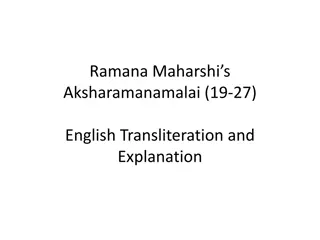
Transliteration Guidelines in Islamic Contexts
Learn about the rules for transliterating Arabic words in Islamic contexts, including the importance of following American spelling standards, not transliterating certain Arabic names, checking pronunciation accuracy, and forming plural forms of transliterated nouns. Understand how to handle Arabic letters and their equivalents in English for accurate transliteration.
Download Presentation

Please find below an Image/Link to download the presentation.
The content on the website is provided AS IS for your information and personal use only. It may not be sold, licensed, or shared on other websites without obtaining consent from the author. If you encounter any issues during the download, it is possible that the publisher has removed the file from their server.
You are allowed to download the files provided on this website for personal or commercial use, subject to the condition that they are used lawfully. All files are the property of their respective owners.
The content on the website is provided AS IS for your information and personal use only. It may not be sold, licensed, or shared on other websites without obtaining consent from the author.
E N D
Presentation Transcript
TRANSLITERATION It is meant the replacement of source language letters ( i.e. graphological units ) by non-equivalent target language letters, based on a set of conventionally established rules. Also, Transliteration means transferring the letters or characters (of a word) from one alphabet to another . For example: Alcohol = Aspirin =
Transliteration in Islamic contexts 1. American spelling is the standard. Whenever there is a difference between American and British spelling, abide by the American rules. For example: AMERICAN SPELLING BRITISH SPELLING Honor Honour Muhammad Mohammed Muslim Moselm Organize Organise Toward Towards ) ( ) ( 2. When the Arabic word dhu transliterated as Dhul- . For example: Dhul-Hijjah comes before the definite article , it is Dhul-Qarnain
3. Some Arabic names (such as names of Prophets, angels and some places have conventional spelling in English literature and dictionaries. These names are to be written according to the accepted spelling and not transliterated. For example: Mecca Medina Syria Gabriel Moses Avicenna Saladin 4. Names that do not have conventional English spelling should be written consistently according to transliteration rules. For example: Umar bin Al-Khattab Al-Muzdalifah
5. Any doubtful pronunciation of Arabic words should be checked first in a reliable reference before being transliterated. For example: Abu Rauh Ibn Muhriz Abu Burdah 6. No special consideration is given to the inflectional position of an Arabic word in Arabic sentences. Even if the name is given different vowel marks in different locations, it should be written the same in all instances. For example: `Abdullah narrated In Dhul-Hijjah
7. To make plural form of a transliterated noun, just add s at the end of the singular form. For example: SINGULAR PLURAL hadith hadiths Dirham dirhams dinar dinars However, some Arabic plural forms are popular in literature. You can use them, but just be consistent. For example: Ansar Muhajirin fatawa mujahidin
8. When Arabic letters which are represented with one English letter are doubled, the English equivalent should also be doubled. Example: Shaddad Ghassan Muttalib Sometimes an Arabic letter is represented by a combination of two English letters. In this case when the Arabic letter is doubled, the English equivalent is not. For example: Bashar Nakhal ( 9. Names beginning with the Arabic word `abd ( example: are transliterated as `Abdul- . For `Abdul-Rahman Abdul-Razzaq `Abdul-Qadir However, there are some exceptions to this rule with names that are usually written as one block. For example: `Abdullah `Ubaidullah


